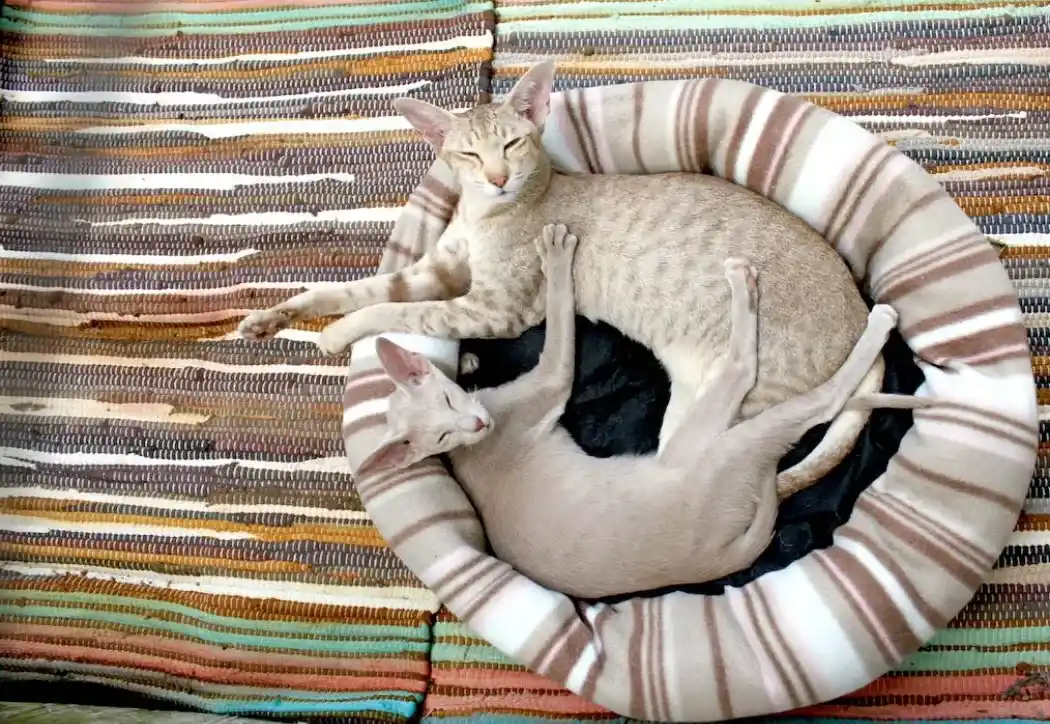How Long Does It Take for Cats to Get Along

Published by: CatsLib
5 Min Read
Slow and Gradual Introduction: It's essential to introduce cats slowly and gradually. Start by keeping the new cat in a separate room with all the necessary amenities (bed, litter box, food, water). Allow the cats to become familiar with each other's scents through scent swapping, using a cloth or toy that has been in contact with each cat.
Visual Introduction: After a few days of scent swapping, you can allow the cats to see each other without direct contact. Use a baby gate or cracked door to let them observe each other from a safe distance.
Controlled Contact: Once the cats seem comfortable with the sight and scent of each other, you can try controlled physical interactions. Keep the initial interactions short and positive. If there are signs of aggression or tension, separate them and try again later.
Positive Reinforcement: Associate positive experiences with each other's presence. Use treats, playtime, and praise when they are near each other to create positive associations.
Separate Resources: Ensure that each cat has its own resources (food bowls, litter boxes, resting spots, toys) to prevent competition and territorial disputes.
Patience: Be patient and don't rush the process. Cats are territorial animals, and establishing a new social hierarchy takes time.
Veterinary Check: Before introducing new cats, ensure that they are both in good health and up-to-date on vaccinations. This helps prevent the spread of diseases and minimizes any stress due to health issues.
Watch for Signs: Watch for body language and behaviors that indicate stress or aggression, such as hissing, growling, puffing up, swatting, or hiding. If these behaviors escalate, it might be necessary to consult with a veterinarian or a professional animal behaviorist.
Supervision: Always supervise interactions between the cats, especially in the early stages. Gradually increase the amount of time they spend together as they become more comfortable.
Remember that there is no set timeframe for cats to get along. Some might become friends in a matter of days, while others might take weeks or months. The key is to be patient, observant, and adaptive to their individual needs and progress. If you're encountering significant difficulties or aggression, seeking advice from a veterinarian or a professional animal behaviorist can be beneficial.
How Long Does It Take for Two Cats to Get Along
The time it takes for two cats to get along can vary widely based on several factors, as mentioned earlier. On average, it might take anywhere from a few weeks to a few months for two cats to establish a positive relationship. However, it's crucial to understand that there is no fixed timeline, and the process could be shorter or longer depending on the individual cats' personalities and circumstances. Some cats might become friends relatively quickly, while others might need more time to adjust.
The success of their interaction depends on factors such as their temperaments, past experiences with other cats, their socialization history, and how well they are introduced to each other. Gradual and patient introduction techniques, as outlined in the previous response, can significantly influence how quickly they become comfortable with each other.
Remember that even after they have started getting along, occasional minor disagreements might still happen. It's essential to continue providing a positive environment and monitoring their interactions, especially during the initial stages. If you're concerned about their behavior or if there are signs of aggression or distress, don't hesitate to seek advice from a veterinarian or an animal behavior professional.

Why Don’t Cats Get Along With Other Cats
Cats can be quite territorial animals, and their social behaviors are influenced by their evolutionary history and individual personalities. There are several reasons why cats might not get along with other cats:
Territorial Instincts: Cats have strong territorial instincts, which can lead to conflicts when they perceive another cat as an intruder in their space. They might hiss, growl, or even become aggressive to defend their territory.
Social Hierarchy: Cats have a complex social hierarchy, and introducing a new cat can disrupt the established order. Cats may need time to establish their roles within the household, which can lead to tension and conflict.
Personality Differences: Just like people, cats have individual personalities. Some cats are more outgoing and social, while others are more reserved and prefer their own space. Personality clashes can lead to conflicts between cats.
Scent and Familiarity: Cats rely heavily on scent to recognize each other and their territory. The introduction of a new cat brings unfamiliar scents, which can be stressful and trigger defensive behaviors.
Past Experiences: Cats that have had negative experiences with other cats in the past, such as fights or bullying, may be more hesitant to get along with new cats.
Resource Competition: Cats can become territorial when it comes to resources such as food, water, litter boxes, and resting spots. If these resources are limited or not properly distributed, it can lead to conflicts.
Lack of Socialization: Cats that have not been properly socialized with other cats during their early kittenhood might struggle to understand and interact appropriately with other feline companions.
Health Issues: Cats in pain or discomfort due to health issues might become more irritable and less tolerant of other cats.
Stress: Changes in the environment, routine, or living situation can lead to stress in cats. Stressed cats might be more prone to conflict with other cats.
Despite these challenges, many cats can learn to coexist peacefully with proper introductions, patience, and management. It's important to note that not all cats will have trouble getting along. Some cats form strong bonds and companionships with their feline housemates. Proper introductions, giving them separate resources, and providing enrichment activities can help improve the chances of cats getting along in a multi-cat household. If you're experiencing difficulties, seeking advice from a veterinarian or a professional animal behaviorist can provide valuable insights and guidance.



